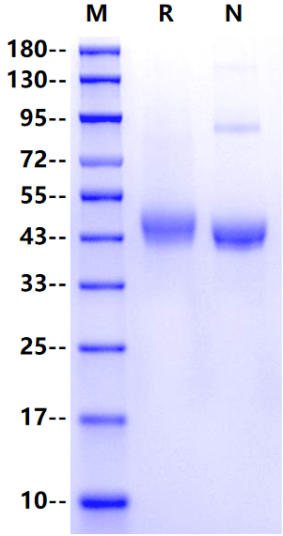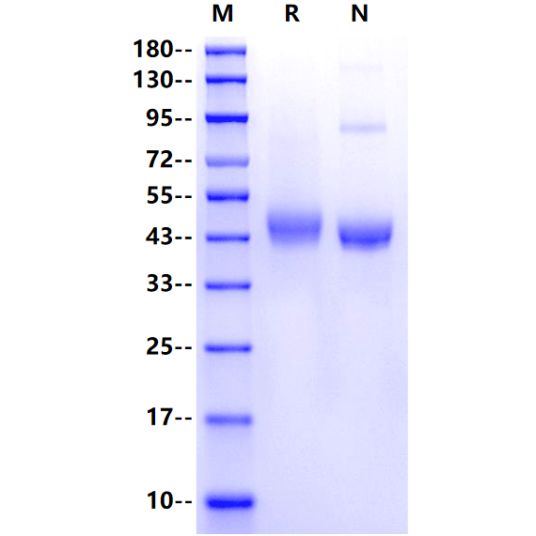1μg (R: reducing conditions, N: non-reducing conditions).
Product Details
Product Details
Product Specification
| Species | Mouse |
| Antigen | SFTPD |
| Synonyms | SP-D, PSP-D, SFTP4, COLEC7 |
| Accession | P50404 |
| Amino Acid Sequence | Ala20-Phe374, with C-terminal 8*His AEMKSLSQRSVPNTCTLVMCSPTENGLPGRDGRDGREGPRGEKGDPGLPGPMGLSGLQGPTGPVGPKGENGSAGEPGPKGERGLSGPPGLPGIPGPAGKEGPSGKQGNIGPQGKPGPKGEAGPKGEVGAPGMQGSTGAKGSTGPKGERGAPGVQGAPGNAGAAGPAGPAGPQGAPGSRGPPGLKGDRGVPGDRGIKGESGLPDSAALRQQMEALKGKLQRLEVAFSHYQKAALFPDGRSVGDKIFRTADSEKPFEDAQEMCKQAGGQLASPRSATENAAIQQLITAHNKAAFLSMTDVGTEGKFTYPTGEPLVYSNWAPGEPNNNGGAENCVEIFTNGQWNDKACGEQRLVICEFGGGSHHHHHHHH |
| Expression System | HEK293 |
| Molecular Weight | 43-50kDa |
| Purity | >95% by SDS-PAGE |
| Endotoxin | <0.1EU/μg |
| Conjugation | Unconjugated |
| Tag | His Tag |
| Physical Appearance | Lyophilized Powder |
| Storage Buffer | PBS, pH7.4 |
| Reconstitution | Reconstitute at 0.1-1 mg/ml according to the size in ultrapure water after rapid centrifugation. |
| Stability & Storage | · 12 months from date of receipt, lyophilized powder stored at -20 to -80℃. · 3 months, -20 to -80℃ under sterile conditions after reconstitution. · 1 week, 2 to 8℃ under sterile conditions after reconstitution. · Please avoid repeated freeze-thaw cycles. |
| Reference | 1. Kuroki Y, Voelker DR. Pulmonary surfactant proteins. J Biol Chem. 1994;269:25943–25946. |
Background
Surfactant Protein D (SP-D, gene name: SFTPD) is a pattern recognition molecule belonging to the family of collections expressed in multiple human organ systems, including the lungs. SFTPD is located at the genomic position 10q22.2‐23.1. In addition to the respiratory system, SFTPD is also expressed in several other tissues/organs, such as the brain, pancreas, kidney, gut, endothelium, and reproductive system. SFTPD was initially identified to be expressed and secreted in lung alveolar epithelial type II cells and plays a crucial role in protecting the lung from inhaled microorganisms, organic antigens, and toxins by recruiting the innate immune system and consequently regulating inflammatory activities. SFTPD is a critical component of the innate immune system intrinsically linked to energy metabolism. SFTPD plays an important role in the innate immune system by binding bacteria, viruses, fungi, and parasites for clearance via opsonization in phagocytes, as well as aiding in the removal of allergens.
Picture
Picture
SDS-PAGE



